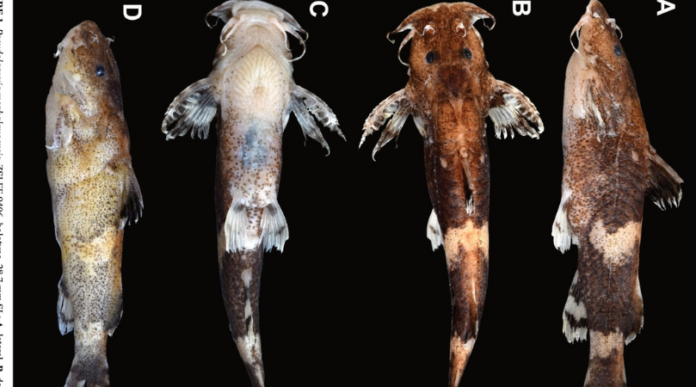GUWAHATI:
A new diminutive sisorid catfish, Pseudolaguvia meghalayaensis, has been discovered by researchers of Assam Don Bosco University (ADBU) in the confluence of Rongkil and Rongdal streams in North Garo Hills, Meghalaya.
As part of her dissertation, Pringranchi Dokgre Marak, a student of zoology in Assam Don Bosco University back then had first brought the species to the notice of Dr Yumnam Lokeshwor Singh, Associate Professor of Department of Zoology at Assam Don Bosco University.
So far, Pseudolaguvia is moderately diverse with 24 total valid species. Pseudolaguvia species can be characterised into two groups based on the presence or absence of serrations on the anterior edge of the dorsal spine. There are 14 valid species of Pseudolaguvia with a smooth anterior edge of the dorsal spine, of which 12 have been reported from Assam’s Brahmaputra basin.
This sample of fishes collected from the confluence of Rongkil and Rongdal streams flowing into the Brahmaputra drainage included specimens of a Pseudolaguvia which are found to belong to an unknown species. It has herein described as Pseudolaguvia meghalayaensis.
The Rongkil and the Rongdal streams originate from the Imsambal and the Tokkol villages in North Garo Hills, Meghalaya respectively, draining north and converging at Wari, Rajasimla Meghalaya before entering Rangjuli in Assam.
It then debouches to the Brahmaputra in Goalpara district of Assam. The type locality was a shallow stream with a moderate to strong current and a substrate of sand and pebbles. One or more species each of Pethia, Puntius, Badis, Channa, Paracanthoco bitis, Barilius, and Opsarius were collected with the new species.
Pseudolaguvia meghalayaensis differs from all congeners in having the striae in the thoracic ad-hesive apparatus strongly anastomosing and break up into small, rounded plaques posteromedially. It is further distinguished from them except P assula, P. austrina, P. ferula, P. ferruginea, P. foveolata, P. inornata, P. jiyaensis, P lapillicola, P magna, P nubila, P shawi, P spicula, P vespa and P viriosa in the absence (vs. presence) of serra-tions on the anterior edge of dorsal spine. However, it differs from the remaining fourteen species with smooth an-terior edge of dorsal spine and in the absence of a central space in thoracic adhesive apparatus.
It can also be distinguished from its congeners in having the combination of
characters: thoracic adhesive apparatus length 1.7 times of its width, 8 branched pectoral-fin rays, supraoccipital spine not reaching nuchal shield, pectoral-fin length.
Pseudolaguvia meghalayaensis samples have been reported to the Zoological Survey of India (ZSI) and will add to the natural depository.
Dr Singh said that the North East is very rich in flora and fauna such research helps in preservation of rare species that may go extinct if steps are not taken.
“Although, the research work had started about three years ago”, informed Dr Yumnam Lokeshwor Singh, “We could not publish the paper until recently because of the pandemic.”
“The paper has gone through several reviews by renowned researchers from various institutions” said Dr Singh.
The paper has been published in Zootaxa, a peer-reviewed international journal for rapid publication of high-quality papers on any aspect of systematic zoology, with a preference for large taxonomic works such as monographs and revisions. Zootaxa considers papers on all animal taxa, both living and fossil, and especially encourages descriptions of new taxa.
On the news of the discovery, Fr. Dr Stephen Mavely, vice-chancellor at Assam Don Bosco University wrote, “Dr Lokeshwor…you keep surprising us all with regular posts about your research efforts wrote.”


